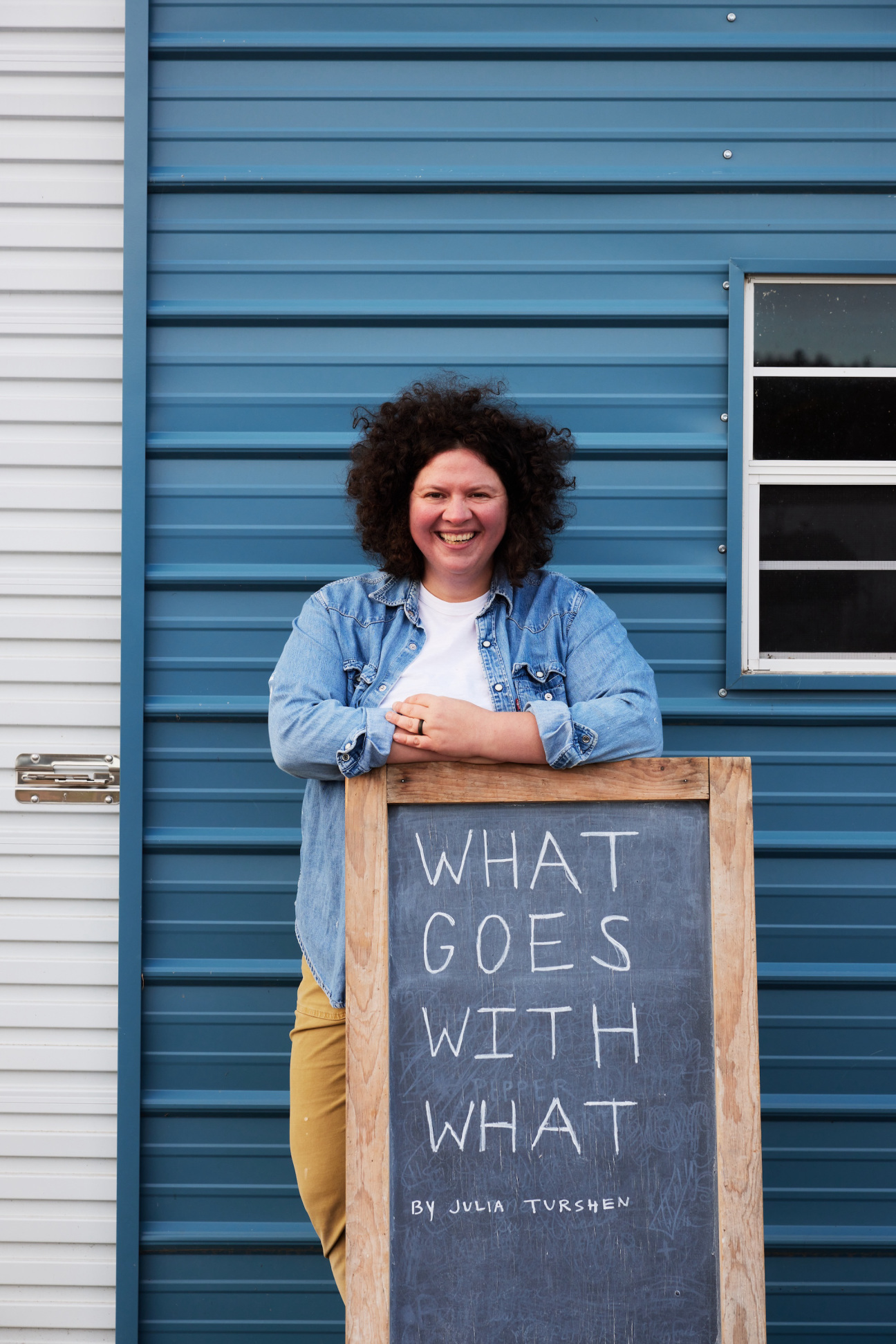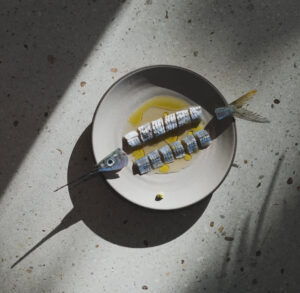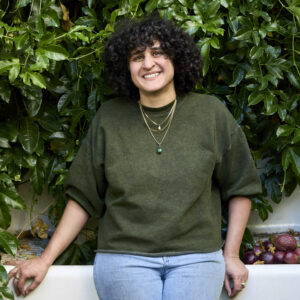
It is perhaps ironic that Julia Turshen, a recipe developer who started her career collaborating with the aspirational lifestyle guru Gwyneth Paltrow, has become one of the most practical, accessible cookbook authors working today. Her latest book, What Goes With What, takes an interactive approach to cooking. It comprises 20 charts that lay out the fundamental components of different types of foods (salads, stews, pasta) and how home cooks can use these building blocks to riff and produce up to 100 different recipes.
Turshen’s philosophy is: give a man a fish recipe and you’ll feed him for a day; give him a matrix for how to approach cooking fish in general and you’ll feed him for a lifetime. Turshen, who lives in upstate New York with her spouse, the design author Grace Bonney, has made a career out of providing home cooks with simple, friendly recipes through her books, newsletter, and online cooking classes.
Ahead of her latest release on Oct. 15, CULTURED caught up with Turshen to discuss how to make a recipe chart and why, sometimes, food that is just good enough is exactly what we need.

Where are you, and what's in your system right now?
This is funny. I am parked outside of my dentist’s office because there’s a big dead zone between my house and my dentist, so I thought I should get there early. This morning, I had a thick piece of sourdough toast and cottage cheese and drizzled very expensive olive oil that someone sent me, salt and pepper, and iced coffee.
This is a book of your recipe charts. For the uninitiated, can you explain what a recipe chart is?
I give you the infrastructure for a recipe and then a number of examples to show how you can follow that formula to make any number of varieties of that recipe. So the book is those charts followed by written recipes for each of the examples. The charts are the best way I have found to show how I think about cooking, which is as this infinitely riffable thing. So many home cooks, myself included, feel overwhelmed by the number of options. Understanding that a lot of recipes are variations on one recipe is a helpful framework. Seeing it on one page, in one chart—it shows that better than I can tell it.
How did you develop the format?
It started when I did this one-pot rice formula in my newsletter. I got such a positive response and I thought, Doesn’t everyone think like this? And I realized, not everyone does.
How do you adapt it to different food categories?
I find the chart through the food, rather than the recipe through the chart. I start with foods I love—what would I most want to share a recipe for? What’s the structure of that recipe? There’s one for salad dressings, a few for soups, one for sheet-pan dinners, one for savory pies.

How do you make such an economical format suitable for different skill levels?
A lot of my work is geared toward people who are not so confident in the kitchen. I want to make sure the person who knows the least feels just as comfortable as everyone else. I never say, “cook onions for 10 minutes” without telling you what they should look like or smell like. My recipe writing goal is to answer questions before you know you have them.
For someone to buy a book, buy ingredients, take the time to make something—that’s a huge amount of trust and I never want to take that for granted. There’s a photo for every recipe and I took them all, which is new for me. It’s not professionally food styled. It’s very much from my kitchen to yours.
Can you share some of your favorite charts in the book?
The final chart is fruit cobblers and crisps. That one I love because it treats baking kind of like cooking—you don’t have to measure things too precisely.
You also began teaching online cooking classes during the pandemic and have continued to do them. What have you learned is the best way to help someone develop confidence in the kitchen?
I wish I could give you one answer, but it depends on the person and how they best learn. I’ve heard from so many people who are neurodivergent and have told me the charts are the first time they’ve really understood cooking. It’s made me get curious about how my brain works. It sounds so obvious, but to help someone be confident is about helping them figure out how they communicate.
I often find myself thinking about something you say in your newsletter, which is that not every meal has to be the best meal you’ve ever had. Sometimes it just needs to be sufficient. This is not something we hear from cookbook authors very much. Why is it important for you to remind people of that?
That refrain came from me saying that to myself, just to lower the pressure. I have noticed what you’ve noticed—that’s not a message most cookbook authors say. We’re all in the business of trying to sell books. I think people feel a lot of pressure to impress—to show you something you’ve never seen. I have nothing against that, but it’s not what I care about. I care about us taking care of ourselves and feeding ourselves and each other. That’s daily, relentless labor. If I’m trying to wow myself or anyone else three meals a day every day, I would get so burned out. I’m in it for the long haul. I find a lot of pleasure in simplicity.

What do you want to see less of and more of in the food world today?
In the food world at large, maybe less pressure for folks to churn out content and more time in between projects. We’re making cooking harder than it needs to be.
Before you moved upstate, you lived in Brooklyn. What’s your go-to bodega order?
Bacon, egg, and cheese; salt, pepper, ketchup. Not original, but it’s great.
What’s the most underrated ingredient?
Carrots are amazing. I put them in so many things. They are a workhorse and so reliable.
Overrated ingredients?
Truffle. Lobster.
Best thing you’ve eaten recently?
I help out at a local farm called Long Season Farm and I brought home some of their heirloom tomato seconds—ones that are a little bruised or split. Yesterday, I had toast with pimento cheese and the heirlooms and it was so good.

What in your kitchen do you splurge on? Save on?
I buy California Olive Ranch olive oil—they sell it by the box, like a box of wine. I buy six boxes at a time and keep them in my cabinet. It’s a lot of money up front but I think maybe it saves me money over time? I also like that Fishwife tinned fish. I spend a lot of money on that. For lunch, I often have a piece of toast with mayo and a can of one of those with a little lemon, chips and a salad.
Because I cook and eat 95 percent of my meals at home, I save money on food in general. I also help out at Long Season and get paid in vegetables. So I don’t spend on vegetables, but I work for them.
Is there a kitchen etiquette rule you live by?
When you are at someone else’s house, always offer to help with dishes.
You can invite three people, dead or alive, to your dream dinner party. Who are they?
This is sappy, but my mom’s parents, because I never met them. And, this is so random, but I also just want to hang out with Doug Emhoff. I think my Jewish grandparents would enjoy his company.










 in your life?
in your life?

